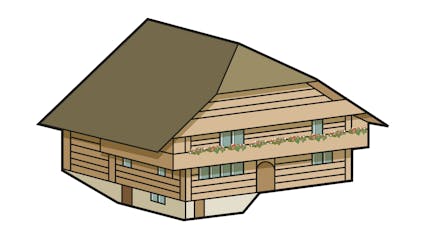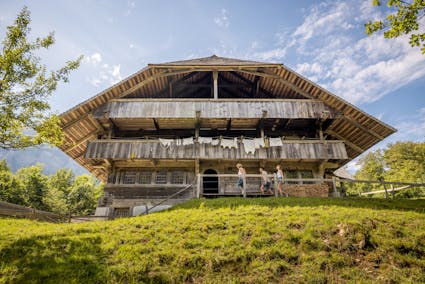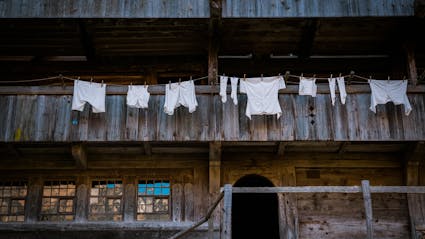351 – Farmhouse from Eggiwil Berne, 17th Century
This building, typical of individual Emmental farmhouses, stood in partially forested hill country 890 metres (2920 feet) above sea level.

Against the tide of time
This building, typical of individual Emmental farmhouses, stood in partially forested hill country 890 metres (2920 feet) above sea level. The typical scattered settlement landscape has numerous separate farms and hamlets. Documents from 1701 mention the new house. In the course of time it was often altered. The multipurpose building remained for an exceptionally long time in old ways of use: Not until 1946 did it get electricity, Lisabeth Bähler cooked until 1974 with wood in the efficiency stove and without running water – this in the middle of Switzerland where houses had been equipped with gas or electricity for decades… Soon enough the family had a new house and a new barn. The old house from Eggiwil regained its original appearance in 1991 when it was re-erected in the Ballenberg Open-Air Museum. The original window rows were reconstructed in new wood.

Product diversification
A stair leads up from the kitchen to a gallery running around three sides of the house. The bedrooms, the barn and storage room for wagons and tools are on this level. Storerooms and granaries are also up here, storage for the grain which was copiously grown in this region in the 17th century. The farmers were largely self-sufficient. Later they reduced grain farming in favour of expanded animal husbandry and cheese production. Especially in the 18th and 19th centuries the region experienced continuing success in the export of Emmentaler cheese. As a sideline to farming, linen weaving in cottage industry was an important source of income in the decades around 1800. In the Eggiwil house the whole family helped out in the weaving cellar.

Where to retire?
The “Stöckli” from Detligen (333) exemplifies a home for retirement widespread in the Berne region. A further solution to the problem of security in old age is the “Schleiss” common in the Emmen valley. The “Schleiss” is actually just a contract between the generations in regard to accommodations, food and fi rewood. The architectural significance of the Schleiss is seen here in the Eggiwil house: There are parlours and bedrooms in both the left and the right halves of the building, one side for the elders, the former farming generation, and one for the active generation of successors. Only the kitchen was used in common. But even here there were two hearths – for avoiding conflict.
“Pure Swissness” tour
Weaving – parlours as production facilities
Many Swiss farmsteads once housed large looms that were often in operation for 16 to 18 hours a day. The whole family helped to produce hemp, linen and cotton fabrics that were sold in Switzerland and abroad. Experience traditional linen weaving at first hand here in the Farmhouse from Eggiwil BE (351). Experienced weavers demonstrate this ancient technique and give insights into the painstaking but fascinating weaving loom work.

Ballenberg
Swiss Open-Air Museum
Museumsstrasse 100
CH-3858 Hofstetten bei Brienz
Company holidays
24 December 2025 to 11 January 2026
Opening hours Administration
3 November 2025 to 8 April 2026
From Monday to Friday
8.30 am to 11.30 am
1.30 pm to 4.30 pm
Opening hours
9 April to 1 November 2026
10 am to 5 pm daily